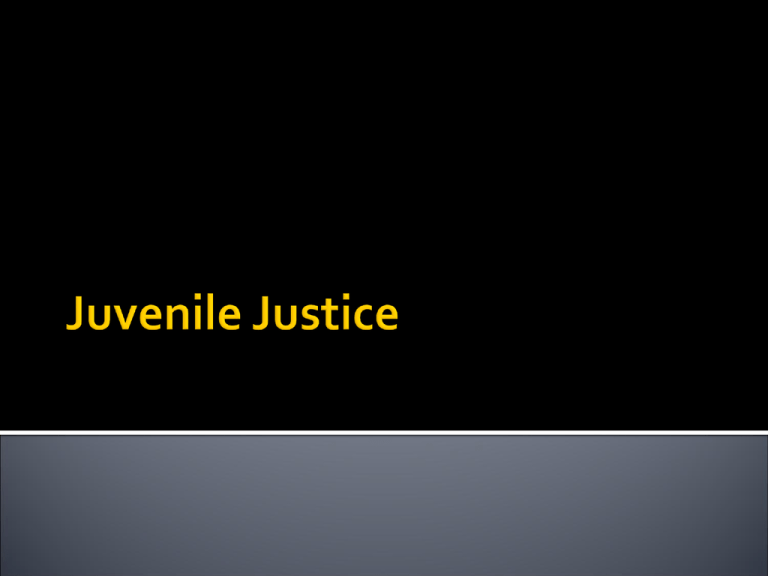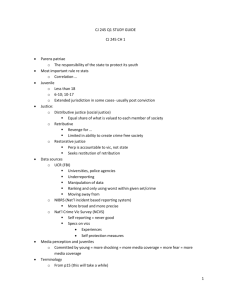The Juvenile Justice System
advertisement

Crime is an age-specific phenomenon (16 – 25) Limited preventative and curative capabilities, and justice intervention tends to make it worse Takes a community raise a child, but sometimes even the communities fail The children today love luxury. They show bad manners, contempt for authority, they show disrespect for elders and love chatter in place of exercise. They no longer rise when their enter the room. They contradict Their parents and tyrannize their teachers. Socrates Steady crime/delinquency rates in some realms Violent crime surge in the post-World War II era: Past feeling case studies (Columbine, Virginia Tech) Oppositional culture of the streets/Code of the Streets Fullerton High study Gang activity (male and female) Protect society Arrest Prosecute Incarcerate The interest of the child Halfway houses Attention Centers Counseling Volunteer programs Parens Patriae Status Offenses (laws that apply only to juveniles) Juvenile Court Hearing v Trial Adjudicated v Convicted Juvenile Prisons/Training Schools Juvenile Probation and Parole Juvenile/Youth-based police bureaus Treatment in the best interest of the child (future tense orientation) Formerly until 21 years old Currently, until the 18th birthday Minimum age is generally 8 Juvenile can be tried in adult court: Every state has different rules/procedures Relatively rare occurrence (7,500/year or about .3% of the cases) In re Gault: juvenile court proceedings must possess the elements of basic fundamental fairness; juveniles have the right: to a proper hearing to advance notification of that hearing and its purpose to be present at the hearing to confront/cross examine the accuser to be represented by legal counsel at the hearing to present evidence against self-incrimination to a formal ruling based on information presented in court to an appeal In re Winship: the standard proof in a juvenile court adjudication is beyond a reasonable doubt McKeiver v Pennsylvania: there is no right to a jury trial for juveniles being adjudicated in juvenile court Seriousness of the offense Prior record Demeanor Social class Basic demographics: Age Race Gender Wolfgang – cohort of 10,000 boys born in Philadelphia in 1945: 1/3 moderate levels of delinquency 6% responsible for ½ of the crimes and 2/3 of the violent crime Current research: 6 to 10 % are persistent life course offenders 50% moderate levels (sporadic youthful ventures) 90% mild levels Why the persistence, why the desistence? Lack legitimate roles Non-conformity Peer pressure Lack of self control/hedonism Biological factors Educational disparity Blank time issues Entertainment exposure Poverty Insufficient positive family impacts: Parental indifference Parental violence Divorce Illegitimacy Single parent homes Blank time (again) Oppositional culture of the streets Chance game Immigration 1. Individual factors - low intelligence, low employability coefficient, poor school performance, limited involvement in positive extracurricular activities, hyperactivity, impulsiveness and risk taking, early antisocial behavior (including aggression and bullying), few bonds to conventional society (friends, girlfriends, parents, teachers, ministers, coaches). 2. Family factors - poor parental supervision, harsh and/or inconsistent discipline, physical abuse, child neglect, low parental involvement, parental conflict, broken/divorced families, single parent families, criminal parents, delinquent siblings. 3. Socio-economic factors - low family income, lack of roots/stability (high mobility coefficient), rent vs. own home, high aggregate socio-economic inequity coefficient in the community, limited opportunity structures 4. Peer factors - delinquent peers, peer rejection, low popularity 5. Neighborhood factors - high crime neighborhoods, high delinquency/high crime schools, high aggregate socio-economic inequity coefficient in the community, limited community-wide opportunity structures 6. Biological factors - poor nutrition, hormonal imbalance Decrease the impacts of the risk factors while simultaneously increasing the impacts of the protective factors in all of these areas (bonds to conventional society, extracurricular involvement, improve academics, improve nutrition, improve parenting, provide opportunities, reduce the aggregate socio-economic inequity coefficient), and the seriousness of crime will be reduced/diminished in the aggregate. Eliminate the entire juvenile justice sub-system and try kids in adult court: Abolish status offenses Abolish juvenile court Abolish the parens patriae orientation Adopt the Blended Sentencing model Transform juvenile prisons into education and training centers with an employment focus Increased socio-economic opportunity structures Increase support for Project Head Start Increase support for Outward Bound: Develops confidence, self-assurance, teamwork, selflessness Expensive, some discrimination issues, transferability concerns Do NOT adopt Scared Straight programs Boot camps (mixed findings) Diet/nutrition/bio-criminological interventions Home Detention Self sentencing Volunteer programs No mixed incarceration Youth oriented public relations law enforcement officer programs (Officer Friendly) Greater use of probation Greater use of Community Courts/Teen Courts (victim-offender mediation modeling) Curfews are ineffective and are empirically invalid Bus ticket model Punishment for parents Face criminal charges Fines Community service Shaming 1. Internal conversion of the treated (fertile ground) 2. Proper timing/zeitgeist (palatable environment) 3. Good program (good seed) 4. Capable program personnel (knowledgeable and skilled farmer) 5. Dedicated and persistent program personnel (hard working farmer) If any one of these is missing, the program fails/the crops fail. Ultimate answers lie outside the justice system (religion, schools, families) Justice systems are designed to buy time, not to serve as the foundations of a society: - more is being asked of the justice system than it was designed to do, and it is swaying under that weight - the justice system, which is so poorly designed, functions as well as it does due to the diligence and dedication of the professionals who fill its ranks The key in this struggle is dedication and persistence Things are hopeless, but we must be determined to make it otherwise, with dedication and persistence Press on. Nothing in the world can take the place of persistence. Talent will not. Nothing is more common than unsuccessful individuals with talent. Genius will not. Unrewarded genius is almost a proverb. Education alone will not. The world is full of educated derelicts. Persistence is singularly omnipotent.


